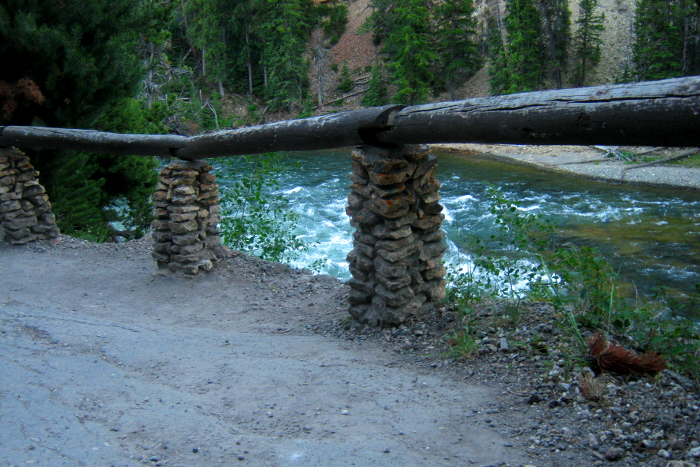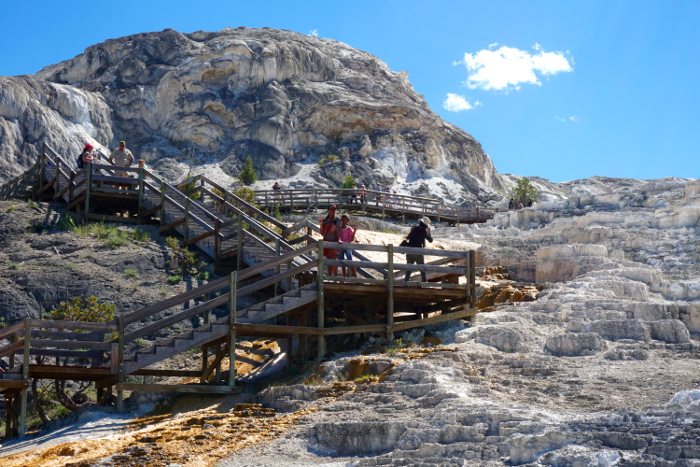Yellowstone's main road is the Grand Loop road which serpentine's 142 miles around Yellowstone
like an inscribed circle on the very heart of the park. This loop connects visitors to every classic gem,
from Mammoth Hot Springs near the North Entrance to Fountain Pots and Old Faithful near the
West and South Entrances. The scenic drive offers splendid view of rivers, waterfalls, meadows,
forests, cliffs, canyons, geysers and a myriad of wildlife
Grand Loop road is a primary road system in the Yellowstone National Park that covers 140-mile
(230 km) . The road was originally planned by Captain Hiram Chittenden of the US Army Corps
of Engineers in the early days of the park, when it was under military administration. It provide
access to the major geothermal areas of the park, including the Upper, Midway and Lower Geyser
Basins, Mammoth Hot springs, Tower Fall, Grand Canyon of the Yellow Stone and lake Yellow Stone
On grand loop road, Columnar basalt cliffs formations overhangs the road at Junction Butte Basalt .
Basalt is a common extrusive igneous or volcanic rock formed from the rapid cooling of basaltic
lava exposed at or very near the surface of a planet or moon. It is less than 20% quartz and less than
10% feldspathoid by volume, and where at least 65% of the feldspar ( mineral with the presence of
alumina and silica ) is in the form of plagioclase.
Columnar Basalt flows formations can also be seen while approaching the Tower falls. Basalt is one
of the most common rock types in the world . It is used in construction ( building blocks ) making
cobblestones for road pavements, (from columnar basalt) and in making statues. Heating and
extruding basalt yields stone wool, which is said to be an excellent thermal insulator.
Tower Fall is a waterfall on Tower Creek on the northeastern region of Yellowstone National Park.
It is located in the Tower- Roosevelt section of the Grand Loop Road at Yellowstone.This scenic
waterfall with an impressive 132 foot drop is surrounded by vibrant green moss . A paved pathway
with signboards takes you from Tower falls store area to an overlook point and provides a
perspective view of the falls. The overlook point is approximately 300 ft above the yellow stone river.
Tower Fall was originally called as Little falls by fur trappers. This chastely beautiful water falls was
renamed as Tower falls by one of the members of Wash burn party in 1870 due to the tower shaped
pinnacles ( volcanic rocks) surrounding it. Almond Gunnison in 1883 wrote " Great towers, shapely
as cathedral spires, rise on either side with slender fingers like the minarets of a mosque strangely
colored forming a royal setting for the water which from 200 ft above falls into a the boiling chasm.
Surroundings are much like Minnehaha falls only here is greater majesty".
The Canyon Village area of Yellowstone is one of the most majestic areas found within the Park
boundaries.Canyon Village is located in the center of the park. Three roads lead to Canyon: Norris is
12 miles to the west; Tower Falls is 19 miles to the north; and Lake Village/Fishing Bridge is 16
miles to the south. Canyon Village is a base camp for exploring the Grand Canyon of the
Yellowstone River, one of the most popular features in Yellowstone National Park.
The canyon offers several hiking trails ranging from easy to strenuous . Uncle Tom's trail having 300
steps takes 500 ft down to the canyon from where Lower fall is clearly visible. South Rim trail
stretches to 3.2 miles takes you to two view points of the Upper falls ( 109 ft down) from where Old
Canyon Bridge is also visible. From the left overlook a glimpse of Crystal falls is also visible.
Another trail which begins at the Grand view parking area is the half mile Grand view Loop trail.
South Rim is a partially paved trail which begins at Wapiti Lake trail head on South Rim Drive near
Chittenden Bridge. It run parallel and connect the Wapiti lake trial head with Uncle Tom's Point and
Artist Point ( 1.75 miles or 2.8 km). The trail offers striking viewpoints of both falls and canyon

North Rim trail takes you to the brink of Lower Falls. Depending on the weather 5,000 to 60,000
gallons of water plunges from a height of 308 ft to yellow stone river. North Rim trails drops to 600
ft and it is not recommended for people with poor health conditions. Another major trail is Red Rock
trail which drops to 500 ft and takes the hardy visitor closer to lower falls . The canyon was a barrier
to early travel, but became a destination for visitors when roads made the park more accessible.

North Rim trail takes you to the brink of Lower Falls. Depending on the weather 5,000 to 60,000
gallons of water plunges from a height of 308 ft to yellow stone river. North Rim trails drops to 600
ft and it is not recommended for people with poor health conditions. Another major trail is Red Rock
trail which drops to 500 ft and takes the hardy visitor closer to lower falls . The canyon was a barrier
to early travel, but became a destination for visitors when roads made the park more accessible.
The Grand Canyon of the Yellowstone is roughly 20 miles long, measured from the Upper Falls to
the Tower Fall area.This unique natural treasure has a depth of 1200 feet and 1500 to 4000 ft width.
Upper and Lower Falls of the Yellowstone River add to the grandeur and make it looks like a
enormously painted mural. Upper falls viewpoint, Artist point (one of the most photographed view
points), Look out point, Red Rock Point, Grand View point and Inspiration Point are view points
which offers a spectacular view of the Grand canyon. Puffs of steam mark the hydro thermal feature
in the canyon walls and the streaking hues along the canyon walls are surreal.
The Upper Falls is upstream of the Lower Falls and is 109 ft. high. It can be seen from the Brink of
the Upper Falls Trail and from Uncle Tom's Trail. The Lower Falls is 308 ft. high and can be seen
from Lookout Point, Red Rock Point, Artist Point, Brink of the Lower Falls Trail, and from various
points on the South Rim Trail. Lower falls is also known as Great fall or Grand falls of Yellowstone.
The Lower Falls is often described as being more than twice the size of Niagara, although this only
refers to its height and not the volume of water flowing over it. The volume of water flowing over the
falls can vary from 63,500 gal/sec at peak runoff to 5,000 gal/sec in the fall.
A third falls is located at the canyon between the Upper and Lower falls. Crystal Falls is the outfall
of Cascade Creek into the canyon. It can be seen from the South Rim Trail just east of the Uncle
Tom's area. This silky 130 ft water falls bounds through pine trees towards the Yellowstone river.
The Yellowstone river snakes through the canyon as it rushes downstream which also cause erosion
when flowing through soft and less resistant rocks thus increasing the depth and width of the
canyon .Yellowstone river is a tributary of Missouri river with a length of 692 miles and the largest
high altitude mountainous river in North America.
Yellowstone river rises in northwestern Wyoming in the Absaroka Range. It is the largest and major
rivers at Yellowstone National Park, though its origin is outside the park. It is also the longest
undammed river in the contiguous North America and thus retain the natural habitat characteristics
and flows. The other major rivers at Yellowstone are Bechler, Firehole, Gallatin, Gardner, Gibbon,
Lamar, Lewis, Madison and Snake river.
Yellowstone’s Grand Canyon is not as big as the Grand Canyon in Arizona, but the beauty and
grandeur is nonetheless breathtaking. The present canyon is estimated to be 10,000 to 14,000 years
old. This recent geologic feature is believed to be the result of erosion rather than glaciation. The
canyon village complex is a part of the Mission 66 project in the park. The Visitor center which
opened in 1957 is also located 1/8 mile southeast of Canyon Junction in the Canyon Village complex.
rivers at Yellowstone National Park, though its origin is outside the park. It is also the longest
undammed river in the contiguous North America and thus retain the natural habitat characteristics
and flows. The other major rivers at Yellowstone are Bechler, Firehole, Gallatin, Gardner, Gibbon,
Lamar, Lewis, Madison and Snake river.
Yellowstone’s Grand Canyon is not as big as the Grand Canyon in Arizona, but the beauty and
grandeur is nonetheless breathtaking. The present canyon is estimated to be 10,000 to 14,000 years
old. This recent geologic feature is believed to be the result of erosion rather than glaciation. The
canyon village complex is a part of the Mission 66 project in the park. The Visitor center which
opened in 1957 is also located 1/8 mile southeast of Canyon Junction in the Canyon Village complex.





















































